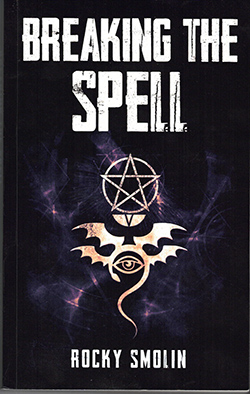Breaking the Spell by Rocky Smolin © 2021; ISBN 9798797-728153l; 324 pages, $13.99 paperback, $3.99 Kindle via Amazon.
 SAN DIEGO – When the man and woman drawn to each other are both septuagenarians you know this will not be the usual type of love story, although a love story it is.
SAN DIEGO – When the man and woman drawn to each other are both septuagenarians you know this will not be the usual type of love story, although a love story it is.
Roger and Frannie had been college friends who never reached intimacy, although secretly both had desired it. They reconnected 50 years after their graduations, both now single. Frannie was divorced from her husband; Roger was a widower.
Both were lonely, and if you had the occasion to probe their thoughts, they both were looking for more purpose in their lives. Roger, in particular, felt that his life was like an “empty cup,” even though he had made lots of money in his career as a tech-savvy investor. However, before the two could develop a lasting relationship, Frannie needed to fly to Myanmar, formerly known as Burma. Years before, she had spent months in Vietnam as a freelance photographer where a Burmese man named Tin Win had been her guide and aide. They remained in friendly correspondence until one day he disappeared. Frannie was determined to track him down.
Just before she was arrested by the authorities in Myanmar, Frannie, knowing she was in trouble, telephoned Roger with an urgent request for help. Like a good knight, Roger decided to fly there to aid his lady.
You come to a point in the story where you think to yourself, “well, there it is; there’s nothing more to say.” But in fact, this ending point also was a beginning point for Roger on his journey attempting to decipher what his life had been all about. Wealthy, urbane, socially attractive, why was Roger unhappy with a life other people might be delighted to emulate?
As the title and book cover art suggest, Breaking the Spell is imbued with witchery. When he was a young man, Roger had been troubled by a woman who refused to end their relationship. He told a witch that he wished to be freed of that woman. The witch cast a spell, and months later the woman died in a car crash. She had been under the influence of alcohol. Was it the witch’s spell or the alcohol that led to her demise? Or perhaps was it a combination of both? Roger wavered between the two poles of thought, until eventually he was able to incorporate in one cranium both science and the occult. Of Jewish faith, perhaps he unknowingly adopted the Talmudic reasoning that majority and minority opinions both have lasting value, and so neither opinion should be discarded.
In witchery, Roger learned, the impact of a spell may come back threefold. This consequence is supposed to happen to the one who cast the spell, that is, to the witch. However, Roger’s witch manipulated the situation so that he, rather than she, suffered from the blowback.
Like Dorothy in The Wizard of Oz, Roger learns that there are good witches in addition to bad witches. Three good witches come to Roger’s aid in this novel. Or did they? Throughout the novel, Roger believes and disbelieves.
Life can be mysterious enough without witches adding to the brew. Figuring out his life’s meaning was more complicated for Roger than it might have been minus the occult occurrences. But if there hadn’t been such occurrences would Roger have had as complete a picture to ponder?
The autumn of our years often involve more reflection and less action. Roger had the opportunity to engage in quite a bit of both. Our thanks for taking us on this journey of imagination go to author Rocky Smolin of San Diego County, who like Roger in the novel, has a technical background in computers, and plays a mean bass.
*
Donald H. Harrison is editor emeritus of San Diego Jewish World. He may be contacted via donald.harrison@sdjewishworld.com